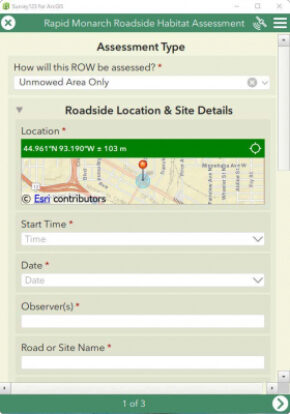

Overview
The Roadside Monarch Habitat Evaluator integrates the Rapid Assessment of Roadside Monarch Habitat and the Monarch Habitat Quality Calculator in Esri Survey123. Roadside managers collect data from roadside rights-of-way through field visits, using the Rapid Assessment protocol. Rapid Assessment data are automatically processed through a "Habitat Calculator" to generate Monarch Habitat Quality Scores. Both the Rapid Assessment protocol and Habitat Calculator can be customized to fit the information needs and preferences of roadside managers.
Data collected from the tool can be used to fulfill monitoring requirements for the Monarch Candidate Conservation Agreement with Assurances (CCAA) if optional fields are completed. Data may be bulk uploaded to the Rights-of-Way as Habitat Geospatial Database. Curious about how the Rapid Assessment might differ from other habitat evaluation tools such as the Pollinator Scorecard or Integrated Monarch Monitoring Program? Check out a comparison here.
Management Application
Roadside managers will find this tool useful in addressing questions about the habitat that exists along their roads, as well as how their management actions (such as weed management or mowing regimes) affect the quality of the habitat. Questions that can be addressed include:
- How much monarch habitat exists along our roads?
- Where is the best monarch habitat in our road system?
- Which areas of poorer quality can be targeted to increase monarch habitat value?
- How do our management practices affect monarch habitat quality?
Habitat Quality Indicators
Monarch habitat along roadways may be broken down into four functional component areas, including breeding habitat (primarily milkweed; Asclepias spp) and foraging habitat for adult butterflies (flowering plants with nectar). In addition, the context of roads and their adjacent land uses affect habitat quality in rights-of-ways. Roads bring threats of collisions with cars and exposure to chemicals; adjacent land uses also can bring threats of chemical drift, and noxious weeds and other plants also can threaten monarch habitat. Management is the final main component affecting habitat quality; variation in the use of herbicides and mowing practices can impact the quality of monarch habitat as well.

